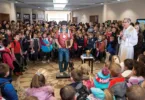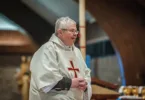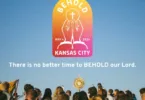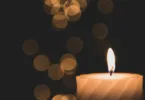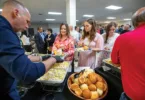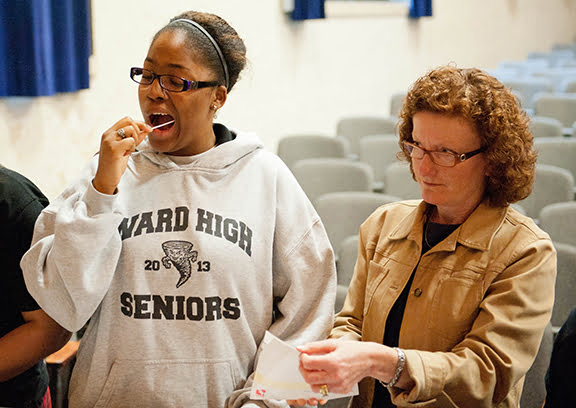
Elexis Whitmore, left, a senior at Bishop Ward High School in Kansas City, Kan., swabs the inside of her mouth as part of the national bone marrow donor registry process. Mary Spangler, right, with Ward’s development office, assists during this inaugural “18 and Swabbin’” drive, which was held at the high school on April 10.
Bishop Ward kicks off effort to add young adults as bone marrow donors
By Jessica Langdon
jessica@theleaven.org
Anticipating all her future will hold, Bishop Ward High School senior Elexis Whitmore was crushed to hear a college student question how much of his future he will even live to see.
“It broke my heart,” said Elexis.
So she joined other high school seniors at Ward in Kansas City, Kan., and across the metropolitan area in a simple step they hope can change the life of that young man — or someone else waiting for a lifesaving bone marrow transplant.
Close to 30 18-year-old Ward seniors filled out some basic paperwork and then swabbed the inside of their mouths on April 10.
With those simple steps, their school made history, holding the very first “18 and Swabbin’” bone marrow donor registration drive for high school students.
Ward administrators, teachers and students collaborated on this new drive with Delete Blood Cancer (DKMS), the world’s largest bone marrow donor center.
Its mission — with the help of high schools like Ward — is to add young adults to the national registry as soon as they turn 18 and are eligible, in order to increase the chances of finding lifesaving matches.
About 20 Catholic and public schools across Kansas City — including Bishop Miege High School in Roeland Park, St. James Academy in Lenexa, and St. Thomas Aquinas High School in Overland Park — are offering 18-year-old students the chance to register this spring.
Organizers hope these drives will soon serve as a model for high schools nationwide.
“We were really honored just to be a part of it, and especially because Bishop Ward was the first one,” said senior Kate Dorian, who is student council president.
“We really hope it can start to be a tradition in the future years so we can get more and more people donating,” she said.
The presentation promoting the drive explained to the students that blood cancer is the second leading cause of cancer deaths in the nation, and it claims more people under 20 than any other disease.
But it did more than that. The April 10 event put a face on the disease for the potential young donors.
Pressing need
Bishop Ward senior Elizabeth Connor was struck by the youth of the four brothers the program featured, all of whom need bone marrow transplants.
The high school seniors are at an age, explained the boys’ father Tim Murry during his presentation, when “your whole life is in front of you. It’s a blank sheet of paper, and it’s a time in your life when you can say, ‘What do I want to do?’ ‘What do I want to be?’”
For someone whose very life depends on finding a marrow match, those questions are much harder to answer.
Murry’s boys — 22-year-old Sean, 18-year-old Patrick, 12-year-old Danny and nine-year-old Timmy — were all born with an extremely rare condition called Diamond-Blackfan anemia.
Basically, their bone marrow doesn’t produce red blood cells.
And for the older two boys, who have endured blood transfusions every few weeks since they were born, the need for a match is particularly pressing because of the excess iron that builds up in their bodies.
That iron eventually threatens their vital organs.
“They don’t know, in my boys’ case, whether they have a few years left. Five? Ten?” said Murry.
The family hopes bone marrow transplants for the four Murry boys would “install” someone else’s blood system into their bodies and enable them to produce blood on their own.
And their family isn’t alone.
About 10,000 people in the United States are waiting for bone marrow transplants, John Murry told the students.
John is Tim’s father, grandfather of the boys, and former president of Bishop Ward’s neighbor, Donnelly College.
About 3,000 of the people who are waiting will likely die this year because they won’t find the “near-perfect match,” he said, of the 10 genetic markers needed to provide a potentially lifesaving transplant.
When a sibling isn’t a good candidate, “it’s like finding a needle in a haystack,” he said.
And yet only about two percent of the U.S. population is part of the national registry.
For more than a year, members of the large Murry clan — including the boys’ cousins here in the Kansas City area — have worked with Delete Blood Cancer and organized drives to register people in parishes, businesses, colleges and at other locations.
In fact, the inaugural event at Ward was a family reunion of sorts. John Murry’s wife, Mary Margaret, and two nieces — Ward graduates Heidi and Caitlyn Muder — assisted at the “18 and Swabbin’” event.
The family hopes that through the drives, they will find donors for their own boys while building up a database of matches for others.
Those drives have so far registered 11,500 potential donors, and about 50 matches have resulted from those registrations, mostly from a handful of colleges.
“That’s why stem cells from you young people are so, so important,” said John Murry.
So important, in fact, that his daughter came up with this idea to extend the registration opportunity to high school students as they hit 18.
Young, healthy, eager to help
Kathleen Murry Parker, a member of Curé of Ars Parish in Leawood, wanted to see as large of an impact as possible on the registry numbers.
Reaching out to students still in high school offers a chance to take the time to really educate people about why this is so vital, she said.
She realized the “18 and Swabbin’” events could not only add many people to the registry at one time, but keep these potential donors on it for the next 43 years, the longest time possible.
The registration window is open to healthy individuals between the ages of 18 and 55 — and time is of the essence.
“There are people who will be diagnosed today who haven’t talked to their doctor yet,” said Tim Murry. “Maybe the appointment is this afternoon, and they’re going to be told today that they have blood cancer, and the clock is ticking and they need a donor right away. That’s the reality for some people’s future.”
Elexis was particularly touched when the classes watched a video featuring the Murry family.
Sean, who is a college student, shared on camera that it’s frustrating to work toward a degree and at the same time wonder if it’s all for nothing.
“Watching the video about the Murry boys and how important a transplant is for them in order to live meant a lot to me,” said Jon Roblez, a senior at Ward. “They are my age, so it really hit home.”
Elizabeth was moved by the boys’ mother, Maggie Murry, who described in the video having to think about the possibility of outliving her children.
“It feels good knowing that you could help somebody else — and it’s easy,” said Elizabeth.
The video featured two men who had registered and actually received calls to donate.
John Murry explained that a small percentage of collections are still taken through the pelvic bone, but in the majority of donations, a synthetic protein bolsters the stem cells in the blood a few days ahead of time. Blood is then removed from one arm, filtered through a machine, and replaced in the donor’s other arm once the stem cells are collected.
“It is a very easy process to register and, from the presentation, I learned that being a donor does not hurt and recovery is easy,” said Jon. “So, there is really no reason that I could think of to not sign up.”
‘We can fix this’
Tim Murry was moved to see more than two dozen seniors stay after the presentation to register.
“They almost ran to the stage,” he said, adding that he’s so impressed with the way young people approach life with an attitude that says, “We can fix this.”
It took just a few minutes and two painless swabs of the inside of their mouths to collect cells to send to the registry.
That part felt a little weird, admitted Elexis, but it was nothing compared to the feeling she could one day make a difference in someone else’s life.
“I kind of got the shakes — like butterflies,” she said.
The whole time, she was thinking, “I’m really doing something.”
Angie Gregory, who is sponsor for Ward’s student council, was impressed — but not surprised — to see students from all walks of life volunteer to help.
“These kids are amazing,” she said. “They are so giving.”
They’re examples to other grades and their teachers, she said.
“Cancer has affected my family. And if there’s anything I can do to help my family or anyone that I could be a match for, I will do it,” said senior Andrew Kump. “Having Dr. [John] Murry and his family come to Bishop Ward taught me a lot, especially about the donation process. I had no idea that it was such an uncomplicated procedure. I’m proud that our school is the first high school to participate, and I am glad I can help.”
Parker stressed, though, that one of the things that has helped this undertaking take off is the enthusiasm with which teachers are incorporating it into their science and health care lesson plans.
“They are so excited about doing this and engaging the students in [promoting] and owning the process,” she said.
Students across town have been taking the lead.
“The kids get it,” she said, and they know how to market this issue to their peers.
A Ward student who won’t turn 18 until summer asked what she should do, and John Murry encouraged those students to celebrate their milestone birthday by visiting the Delete Blood Cancer (DKMS) website to arrange to register at: www.deletebloodcancer.org.
Kate and a few others plan to do just that.
Elexis hopes that she will one day get a call.
“I do pray and hope that I am a match to someone,” she said. “Hopefully, I can succeed in saving a life.”
Could you be a match?
People between the ages of 18 and 55 may register as bone marrow donors.
They should weigh at least 110 pounds, have a body mass index no greater than 40, and be in good general health.
To learn more about blood cancer, registration and upcoming drives, visit the Delete Blood Cancer (DKMS) website at: www.deletebloodcancer.org.
High schools interested in holding an “18 and Swabbin’” drive may also contact Kathleen Murry Parker by emailing her at: kparker1020@gmail.com.

